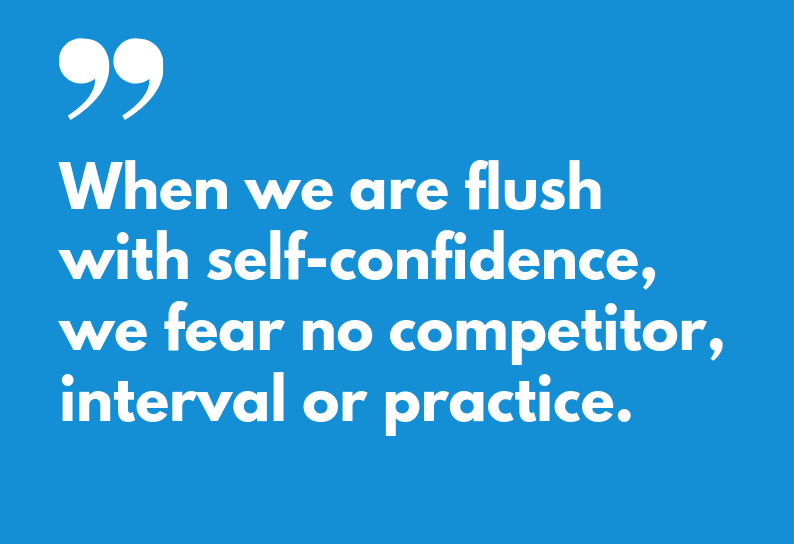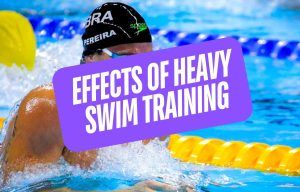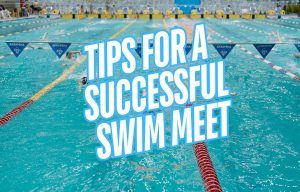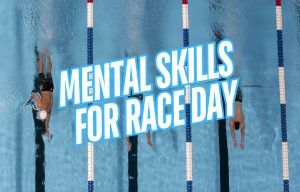Fast swimming means having the self-confidence to know that our best performance will show up on race day. Here are eight proven ways that swimmers can develop superhero self-confidence at the pool.
It’s a trippy time to be a competitive swimmer.
Never has there been more information, whether it’s different swim workouts, nutrition tips, or dryland and weight training exercises that transfer like crazy to your swimming.
You’ve got swim meet results from all over the planet at your fingertips.
Elite swimmers broadcasting the day to day life at the pinnacle of the sport on the Tube of You.
And yet, all of this information and awesomeness comes with some sneaky side-effects:
- All those swim meet results? Great, now you can compare yourself instantly to the swimmer you used to beat who just thrashed your best times.
- All that info on dryland and weight lifting? Cool—there are so many different people telling you what the best program or best exercise is that it leaves you overwhelmed.
- Watching faster swimmers murder your best time repeatedly…in practice and from a push? A deflating reminder of where you’re at.
When it comes to showing up to the pool with a confidant mindset, things get even more perplexing.
Just be confident, your teammate might tell you. Hang in there, a meme will suggest as you scroll through social media.
Sure, you can try telling yourself to be optimistic and positive through gritted teeth, but your brain is on to you—it knows that you aren’t being realistic or genuine. No matter how hard you try to force confidence onto yourself, your training and commitment don’t lie on race day.
These struggles with developing real, genuine self-confidence often lead swimmers to give up on the idea that they can become more confident. They withdraw–I’ve never been confidant, I’m not going to be confidant, and that’s that.
But being self-confident, and getting all the benefits that go along with it, doesn’t need to be such a pain in the butt.
And that starts by not treating it as something you “just have” or something you can’t spend a little bit of time each day to increase.
Confidence isn’t something you “just have”–it’s something you develop
Before we dive head-first into figuring out how to build more self-confidence, it’s helpful to get a deeper understanding of what confidence is, what it does, and how swimmers inexplicably leave their self-confidence to chance.
When we are rolling hard and deep with self-confidence the sport is at our mercy. The swim workouts get pummeled. We smash through the pain and agony. We fear no competitors, intervals or lactate sets.
High levels of self-confidence have been shown repeatedly in study after study to be linked to elite and high-performance athletes. No big surprise there—when we are confident we tend to perform well.
You are already well acquainted with the flip side—when your self-confidence sags motivation to go to swim practice drops like a brick in the deep end. Pre-race nerves begin to make you feel fearful and anxious before competition. You resist when it comes to trying harder sets, intervals, or breathing patterns. You aren’t as focused in practice and the struggle to conquer tough workouts becomes more struggley.
Swimmers often make the mistake as viewing their self-confidence like it’s a factory setting.
Something that comes packaged on arrival. Something we either have or don’t.
But here’s the truth:
Confidence is a skill.
Confidence is something you can train, sharpen and develop just like you improve your technique, increase your ability to withstand a tough interval, or lift heavier and heavier weights in the gym.
Stop viewing confidence as something that is innate or as something that can only be turned up after we post a personal best time or win a gold medal.
Confidence isn’t something you have to fake.
There are times where it feels like we are trying to put on a brave face at the pool. We are scared, doubtful, intimidated. And so we “fake it till we make it.”
Your brain is smart enough to differentiate between real and fake confidence, and trying to out-confidence a lack of training has a low ceiling of effectiveness.
Instead, you can develop confidence–real, genuine confidence–and do the training in the water that substantiates it.
When you head to the pool this week, do so with a blueprint that will help you develop super-power confidence in the short and long term.
Here’s how.
1. Recognize the things you’ve done well.
The confidence we feel toward future events is largely built on the experiences of the past and present. This is why our self-confidence can feel like an amusement park theme ride, taking corners and changing direction from moment to moment.
The examples of how past and present performance dictate confidence are almost endless:
- We have a couple great workouts, and our self-confidence shoots through the roof…
- We crush a personal best time on the first day of the meet, so we feel confident in our chances for the rest of the meet…
- We have a bad workout, which makes us think that the next one is going to be crappy too…
- A bad race on opening night demolishes our hope that we will swim fast all weekend…
- We chlorinate our pants leading into a big meet because we aren’t hitting race pace targets in practice.
The main problem with the amusement park Self-Confidence Ride is that we over-emphasize the drops.
Our brain is hard-wired to obsess and focus on the times where things didn’t go our way. The workouts we missed. The missed race pace targets. The slower than expected swims off the blocks at practice.
Which means we need to do a better job at recognizing the awesome stuff that we do.
This takes little time and effort. Grab a piece of paper and a fountain pen (or whatever) and write out the moments where you killed it in practice (and competition) recently.
Keep your little list, your own personal Hall of Fame, visible and read it regularly when you feel your confidence wavering. Add to it when you do something rad.
You’ve downplayed your successes in the water for too long. That stops today.
2. Set big goals that will push you but that are realistic.
Goal setting looks simple, but the process of setting really good goals is actually harder than it looks. Especially for the swimmer who really has big goals and dreams.
One of the odd paradoxes of goal setting is that there is such a thing as goals that are too big. Although I regularly talk about the importance of having big, border-line insane goals, there is a point that they lap being ambitious and overtake being unrealistic.
How do you know when that is the case?
Here are some hints:
- You feel like you are never making any kind of meaningful progress towards your big goal…
- You get frustrated and withdraw consistently in training because you aren’t improving fast enough…
- When someone else swims a time that you dream of swimming, you get super demotivated…
- Your current training habits, effort and attendance are about nine hundred miles away from the training habits you would need to achieve your big goal.
The resistance to realistic but big goals happens because swimmers find the idea of making their goals realistic insulting or beneath them. Their ego isn’t interested in hearing about realistic goals, it wants the most biggest, most awesomest things ever… or nothing at all.
At the end of the day, your big goals are for motivation and confidence-building. They are a tool to keep you invested in your process. They should keep you invigorated and pumped up to go to practice. They should fuel your desire to execute your daily process, the secret engine of self-confidence (plenty more on that shortly).
By having outrageous, unrealistic goals you are setting yourself up for failure before you’ve really given yourself a chance to put in some work. And what happens when you continue to run into this wall of failure, over and over again?
You guessed it—your self-confidence gets crumpled up like a Kleenex on the first day of cold and flu season.
3. Set training goals and short-term goals.
Training goals are a powerful way to build self-confidence and unleash hyper-improvement in the water.
Practice and short-term goals are handy for the swimmer who makes a hobby out of stressing out about whether they will achieve their goals down the road. Writing out things you want to do today, tomorrow and this week takes you out of the mindset where you are obsessing and stressing on that big goal of yours (and feeling the doubt and ebbing of confidence that is typical when we reflect on the uncertainty that surrounds our goals).
Instead, you become more present with your swimming, maximizing your training and giving yourself countless opportunities to build micro-bursts of self-confidence.
Each week sit down with your log book or a piece of paper and write out a handful of things you would like to accomplish at practice over the course of the week. This little exercise does a few things, including giving you ownership and accountability of your swimming, makes you more focused when you step out onto the pool deck, and gives you plenty of opportunities to create small wins.
All three of these things will help power up your self-confidence, so take a few minutes each Sunday night and decide what you want to accomplish at practice over the coming week.
4. Write up self-talk to battle back against the thought patterns that chip away at your confidence.
Negative self-talk is a confidence killer.
There’s no way around it.
You will never get anything meaningful done in the pool or in life if your inner monologue is saying crap like: You can’t do this set. You can’t make this interval. You won’t swim fast on race day. You smell like chlorine and failure.
These negative thought patterns decimate your self-confidence before you even have a chance to see what you are capable of in the water.
Make the decision to choose the self-talk you want to use. Your new self-talk doesn’t need to be overly optimistic or cheery. Your brain will see right through the fake optimism. Productive and motivational self-talk provides you with an opportunity to get curious about what’s possible instead of shutting things down.
Take a look at the thought patterns you use in practice and competition, and once you’ve nailed down a couple, write up some realistic counter-arguments:
- I can’t make this interval -> I’ve risen to the challenge before, I can rise to this challenge too.
- I’ll never be able to do this whole practice -> The workout looks tough, but I will do the first round best I can and take things from there.
- I am going to swim like hot garbage on race day -> I might not feel great in the water today, but as long as I prepare as best I can, the results will take care of themselves.
Use your self-talk to find the challenges and opportunities in the tough moments you face in the pool.
5. Review your environment for confidence-building cues and signals.
The people we hang out with, the swimmers we train with, the environment we build around ourselves all play a role in shaping how confident (or not) we feel on a daily basis.
Each day while we walk around the world, from the pool, to school, to work, to the pool, to the head-first, arms-at-the-side-dive we do into dinner after PM practice, the environment is firing off a metric ton of cues and signals that influence our confidence.
For example, when we spend time with swimmers who are genuinely confident you can’t help but feel the same way. The same goes when we hang out in the lane full of naysayers and complainers. Self-confidence is contagious. For better or worse.
This is a positive piece of breaking news, because there are countless opportunities to build an environment that boosts confidence:
- Put your list of Hall of Fame moments somewhere prominent
- Post positive mantras and pieces of self-talk in places where you will see them often (see previous point). Post “Eat like a champion!” on the fridge. “Persist!” on your water bottle. Etc.
- Spend more time with friends and swimmers who are doing big things—their ambition and self-confidence will rub off on you and give you models to base your own self-confidence off of.
6. Be honest with yourself about the things that shape your confidence.
Here’s another fun little exercise.
(I know, I know… like you don’t have enough homework, right?)
We are going to break down the things you do and focus on at the pool and consider whether they give you confidence. More critically, we are going to really focus on the things that bring you confidence that you control.
This distinction is really important. Winning a gold medal or beating the swimmer in the next lane can make you feel good about where you are at with your swimming. There’s no disputing that. But swimmers place too much emphasis on the things that bring them confidence that they don’t control.
Think of the things that make you feel confident and unconfident. Here is a sample platter of things that drive or pump the brakes on self-confidence. Note which ones you control, and which ones you don’t.
- I feel confident when I beat the swimmer next to me
- I feel confident when I nail all my turns for the whole practice
- I feel unconfident when I lose to the swimmer next to me
- I feel confident when I don’t give up when the main set gets hard
- I feel confident when coach tells me that I am doing a good job
- I feel confident when I swim with great technique for the whole practice
- I feel confident when I do the workout as it was designed to be done
- I feel unconfident when I see other swimmers going way faster than me
- I feel confident when I eat healthy meals
- I feel confident when I make an effort to get to bed early
As you might have picked up while reading these examples, true, legit self-confidence comes from the things you control. From mastering and hammering your performance. Whether it’s technique, mindset, or effort.
Write out a list of things you control that bring you confidence.
Sounds and looks simple, and it is, but don’t let the simplicity of your list get you twisted.
Beneath its basic-ness is a powerful layer of self-awareness that gives you reference points for where confidence comes from. Real, fair-trade, 100% ethically raised confidence.
Use it when times are good to keep you focused on the things that matter and use it in tough times where you feel your confidence drifting away from you.
7. Race day preparation and plans that are all process.
A common issue with swimmers is that they are quite confident leading up to race day, but it’s that last hour or so before race time where confidence plummets.
The experience of racing suddenly gets real. The pressure starts to hit them. The intensity of the competition starts to rise up over them. The swimmers they are racing against loom larger than life.
As a result, their self-confidence, which had been largely stable during practice and leading up to the meet, is suddenly in free-fall.
This last-minute confidence crash is infuriating as it is common. You work your tail off for how long, only to show up behind the block and choke? Super.
While there are a few different reasons your confidence tanks at the last second—needless comparison-making, not framing anxiety as excitement—they can generally all be umbrella’d under low confidence.
Something, somewhere happened along the way in the hour before your race to send your self-confidence into free-fall.
This is why it’s so critical to get down with a pre-race routine. Although elite swimmers look like they are immune to crises of confidence, this is not the case. At all. And it’s why an overwhelming number of them use a set routine on race day to give them something to focus on that isn’t the competition, or the rampant pre-race nerves, or the thousands of people in the stands.
Remember how I was blabbering about how important it is to focus on the things that bring you confidence in practice?
A controllable and simple pre-race routine does the exact same thing. Gives you a series of little wins that you can build on, from the breakfast you eat that morning, the warm-up you use, the playlist you rock out to, the stretching routine, even the performance cues you use during the actual race—these are all controllable little wins that help you stay confident under pressure.
[If you want more information on pre-race routines, check out this blog post I wrote up about how to develop your own pre-race routine.]
8. Use visualization to carpet-bomb the things that cause low-confidence.
Visualization and imagery are a powerful tool that swimmers can use to improve just about every aspect of their performance…including how self-confident they are.
Michael Phelps uses it. Cody Miller, Katie Ledecky, Adam Peaty, Janet Evans, Missy Franklin and Megan Quann use it too.
And with good reason: research has repeatedly shown a connection between high-performance and the use of imagery.
There are plenty of ways to use visualization (I’ve written a little primer guide for novice users of this tool with some best practices) when it comes to increasing self-confidence.
- Visualize the technique and body position you want to achieve in the water…
- Prepare for the pressure and anxiety of competition by mentally rehearsing the emotions and feelings you tend to feel in the minutes and hours before you race…
- Use it before big efforts in practice to get yourself focused on swimming fast.
And so on.
The goal with visualization is to give yourself competition-grade performances without having to go through the physical motions. You build the reps of having done it over and over again so that when the real thing happens, you feel calm and prepared.
Visualization and imagery is wildly powerful, almost as powerful as the real thing, so don’t sleep on this mental training skill for building confidence.
The next step towards more confidence
If you were looking for a magic secret, or shortcut, or some confidence-me-quickly scheme, I’m sorry to disappoint.
Developing epic self-confidence takes time. You need to accrue the experience to develop true, genuine confidence. And you can do this by following these steps:
- Set yourself some training goals.
- Recognize your victories.
- Spend time with people who increase your self-confidence.
- Deploy imagery and self-talk to battle back against performance-killing thought patterns.
- Revisit and refocus on the things that give you confidence.
- Color yourself ten shades of process-oriented.
- And use visualization and imagery to put in the reps.
Do the work.
Show up.
And the self-confidence will follow.















